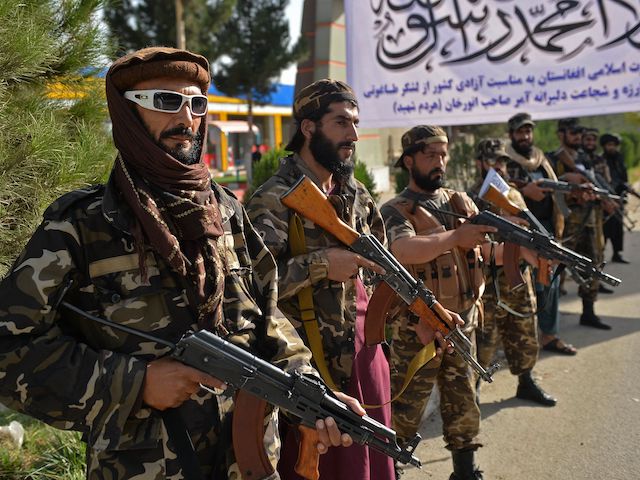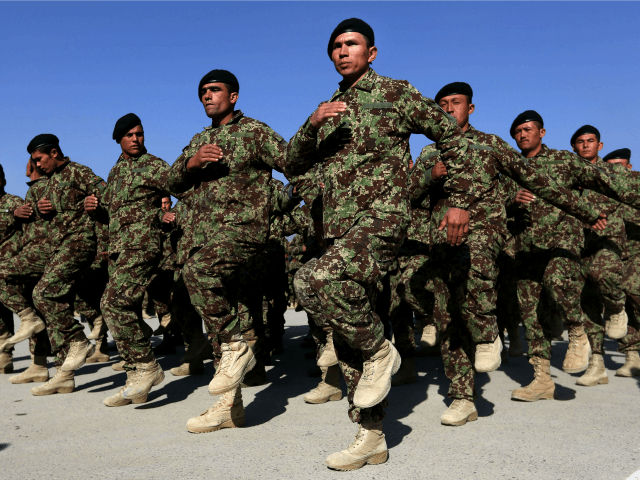The top federal agency in charge of oversight of American involvement in Afghanistan published a report on Friday stating the U.S. government spent nearly $89 billion on “training and equipping” the Afghan military in the past two decades.
The Afghan military, formally the Afghan National Defense and Security Forces (ANDSF), “no longer exist,” the report – the latest installment of its mandatory quarterly report to Congress – noted.
The country’s armed forces collapsed this summer after President Joe Biden announced he would extend the Afghan War, the longest in American history, beyond the May 1 deadline that the previous administration had agreed to in a deal with the Taliban terrorist organization. In response to Biden’s violation of that agreement, the Taliban began a national takeover, conquering every region of the country before taking over the capital, Kabul, on August 15. The Taliban’s rise to power was largely bloodless as a consequence of ANDSF soldiers reportedly fleeing the battlefield en masse or joining the Taliban rather than fighting on behalf of the collapsed Afghan government.
At the time of the Afghan government’s collapse, the Office of the Special Inspector General for Afghanistan Reconstruction (SIGAR) estimated that the U.S. government had allocated $146 billion to “rebuild” Afghanistan after the initial invasion in 2001.
“More important … some 2,400 American service members, and at least 1,233 contractors, including 45 Americans, lost their lives in that country,” the report noted. “Meanwhile more than 21,000 service members and 1,427 contractors, including 38 Americans, were wounded.”
In Friday’s nearly 200-page report, Inspector General John Sopko called the military mission “the single costliest reconstruction effort.” Given that the objective of the investment in the ANDSF was to ensure its success, the fact that it no longer exists suggests that the U.S. received nothing in return for its investment of American taxpayers’ dollars.
SIGAR noted the Biden administration had reason to see the collapse of the country and return of the Taliban, who ruled with an iron fist before the 2001 invasion meant to dethrone it, years before it occurred. SIGAR itself warned in 2014, the current report recalled, “Much of the U.S. reconstruction effort ‘risks being wasted because the Afghans cannot sustain the investment without massive continued donor support.’”

Taliban fighters stand guard near the venue of an open-air rally in a field on the outskirts of Kabul on October 3, 2021, as the Taliban supporters and senior figures held their first mass rally in a show of strength as they consolidate their rule of Afghanistan (Hoshang Hashimi/AFP via Getty Images).
“[U]nder current and future plans, the ANSF [Afghan National Security Forces] is not fiscally sustainable,” the agency warned that year.
The watchdog evaluated “reconstruction” as a separate mission from the Pentagon’s military operations in Afghanistan against the Taliban and its ally organization al-Qaeda. That effort, SIGAR noted, cost $88.3 billion between September 2001 and June of this year, according to the Pentagon. SIGAR accused the Pentagon of failing to provide for a litany of expenditures, however, including:
(1) training and advising programs such as the Train Advise Assist Commands (TAACs), the Security Force Assistance Brigades (SFABs), the Ministry of Defense Advisors (MODA) program, the Afghanistan Hands Program (AHP), and the DOD Expeditionary Civilian (DOD-EC) program; (2) support provided to members of the NATO Resolute Support Mission; and (3) certain advisory and support costs of the Combined Security Transition Command-Afghanistan (CSTC-A) and its successor, the Defense Security Cooperation Management Office-Afghanistan (DSCMO-A)
The agency noted that independent estimates suggest the true cost of the war effort may be in the trillions of dollars.
The Biden administration may lose millions more in training efforts in the near future even when the force it is spending to train does not exist, SIGAR warned. The U.S. still had $356 million in training contracts as of September 13. SIGAR estimated only $141 million of these funds are “recoupable,” meaning another loss of more than $200 million.
SIGAR had identified widespread corruption and incompetence as a significant factor in U.S. government waste in the ANDSF for years. In 2016, SIGAR warned that the Afghan government was reporting “ghost” troops – that is, individuals who do not exist – among the military’s ranks to request funds to “train” them. Much of that money was never accounted for. SIGAR warned that year that Washington had no idea how many ANDSF troops “actually exist.”
By this summer, former Afghan officials were loudly denouncing that the U.S.-backed Afghan government had made it impossible for real Afghan troops to do their jobs.
“There is no motivation for the army to fight for the corrupt government and corrupt politicians here,” former Afghan Ambassador to London Ahmad Wali Massoud told the Wall Street Journal in August. “They are not fighting for Ghani. They haven’t even been fed properly. Why should they fight? For what?”
The collapse of the Afghan military caused international turmoil. More than 1,000 Afghan soldiers fled a Taliban advance in July and crossed into Tajikistan, overwhelming the Central Asian nation. Tajikistan has since urged its larger neighbors like Russia and China to help it maintain stability on its border and announced China would build a military base on the Tajik-Afghan border this week.
On Thursday, Secretary of State Antony Blinken announced the Biden administration would invest $144 million in humanitarian aid to Afghanistan. Administration officials insisted the money would not go to the Taliban.


COMMENTS
Please let us know if you're having issues with commenting.